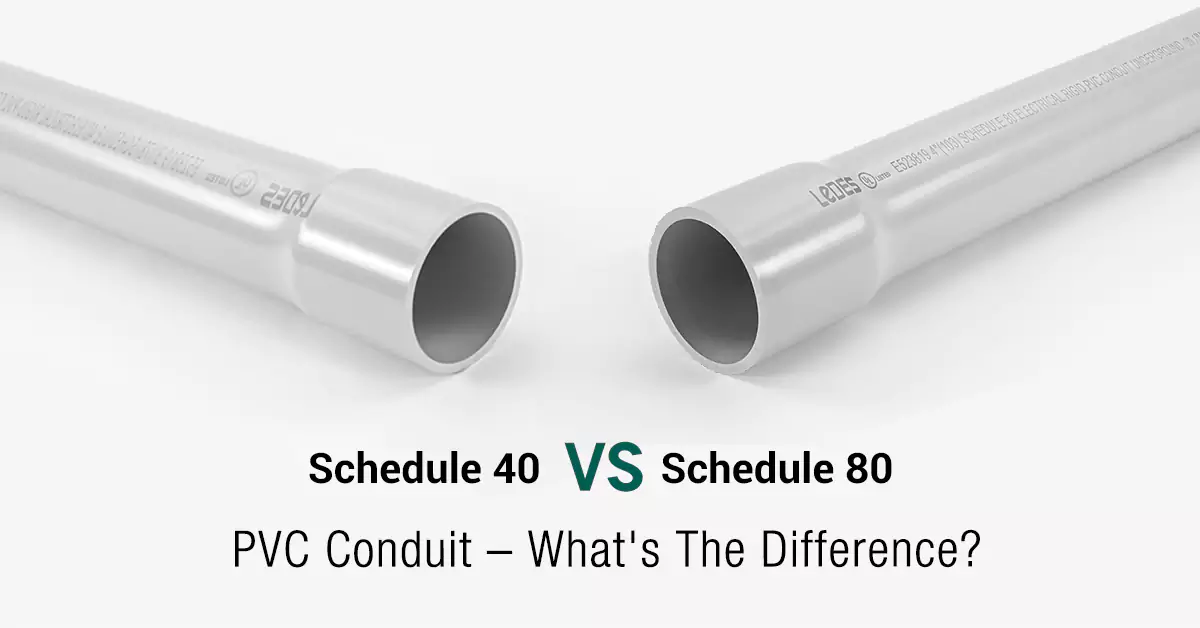
جدول المحتويات
ما الفرق بين أنابيب PVC من النوع 40 والنوع 80؟ هذا سؤال رائع. ستخبرك معظم المنشورات أن المفتاح هو سمك الجدار. هذا صحيح، ولكن ليس كلها. سنذكر 7 نقاط اختلاف في هذا المنشور ونسمح لك بفهم الفرق بين النوعين بالكامل. لذا، فلنبدأ.
- إن أنابيب PVC من الجدول 40 والجدول 80 مصنوعة من كلوريد البولي فينيل (PVC) وتتوافق مع معايير ASTM المعمول بها.
- ويمكنهم الخضوع لعمليات التصديق لتلبية معايير السلامة وضمان الجودة.
يتم تصنيع كل من قنوات الجدول 40 والجدول 80 PVC باستخدام كلوريد البولي فينيل (PVC)، وهي مادة مشهورة بخصائص العزل الكهربائي الممتازة ومقاومتها للتآكل. تضمن عملية التصنيع أن القناة تتوافق مع معايير ASTM (الجمعية الأمريكية للاختبار والمواد) للقناة الكهربائية PVC، مما يضمن جودة وموثوقية المنتج.
فيما يتعلق بقبول السوق والامتثال لمعايير السلامة، يمكن أن تخضع كل من قنوات PVC للجدول 40 والجدول 80 لعمليات الاعتماد لتلبية المتطلبات الضرورية. تضمن الشهادات مثل UL (Underwriters Laboratories) أو ETL (Intertek) أن يتم اختبار القنوات بدقة واعتمادها لأدائها الكهربائي، ومقاومتها للهب، ومقاومة الصدمات، والعوامل الحاسمة الأخرى. توفر هذه الشهادات ضمانًا بأن القناة تتوافق مع معايير ولوائح الصناعة، مما يغرس الثقة في مدى ملاءمتها للتركيبات الكهربائية.
- بالإضافة إلى الجدول 40 والجدول 80، تتوفر أيضًا أنابيب PVC للجدول 20.
- يتوفر النوعان A وEB، حيث يُستخدم النوع A للتطبيقات الداخلية ويُستخدم النوع EB للبيئات المكشوفة أو الوعرة.
علاوة على ذلك، تجدر الإشارة إلى أنه بالإضافة إلى الجدول 40 والجدول 80، هناك أيضًا جدول 20 من قنوات PVC المتوفرة في السوق. تتميز قناة الجدول 20 بجدار أرق مقارنة بالجدول 40 وتستخدم بشكل أساسي في تطبيقات الضغط المنخفض حيث تكون الوظيفة الأساسية للقناة هي حماية الأسلاك الكهربائية.
وفقاً للمعايير، قناة PVC متوفرة في أنواع مختلفة، مثل النوع A والنوع EB. يشير النوع A إلى القناة ذات الجزء الداخلي الأملس ويستخدم بشكل أساسي للتطبيقات الموجودة فوق سطح الأرض. يتم إستخدامها بشكل شائع في المشاريع السكنية والتجارية حيث يتم تركيب القناة في الداخل وحمايتها من الظروف البيئية القاسية. من ناحية أخرى، يشير النوع EB إلى قناة تحتوي على طبقة مدمجة من المطاط الصناعي لمزيد من مقاومة الصدمات. غالبًا ما يتم استخدام هذا النوع من القنوات في البيئات المكشوفة أو الوعرة حيث يوجد خطر أكبر للأضرار المادية.
- يحتوي مجرى الجدول 40 على جدار أرق مقارنة بالمجرى 80.
- الجدول 80 قناةيحتوي على جدار أكثر سمكًا، مما يوفر قوة ومتانة أكبر.
أحد الفروق الأساسية بين الجدول 40 والجدول 80 من قنوات PVC يكمن في سمك جدارها. وفقًا لمعيار UL 651، فإن الفرق الأكثر أهمية بين الاثنين هو سمك جدران القناة. يمكن أن يكون لاختلاف سمك الجدار آثار على عدة عوامل، بما في ذلك الأداء والتكلفة.
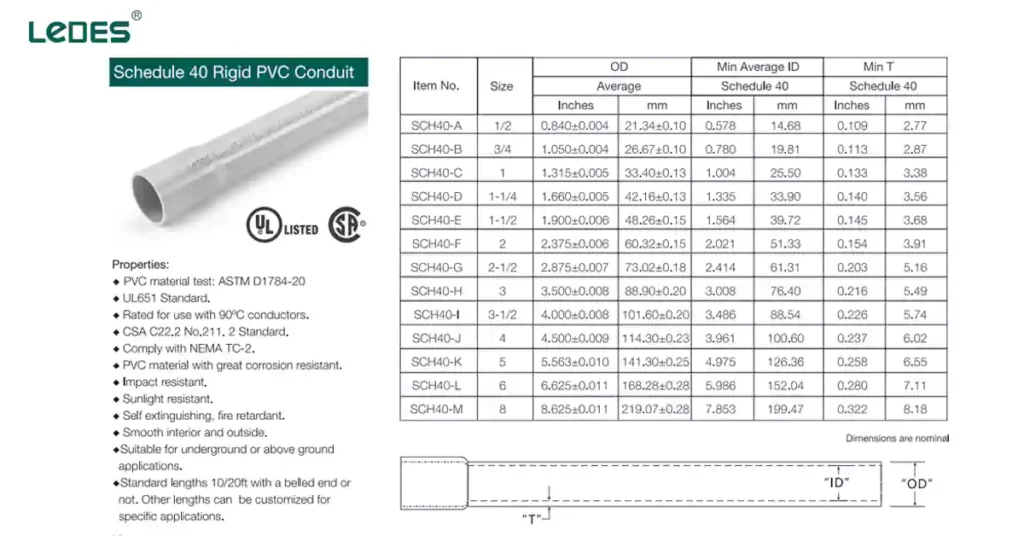
جدول 40 أبعاد القناة الكهربائية PVC
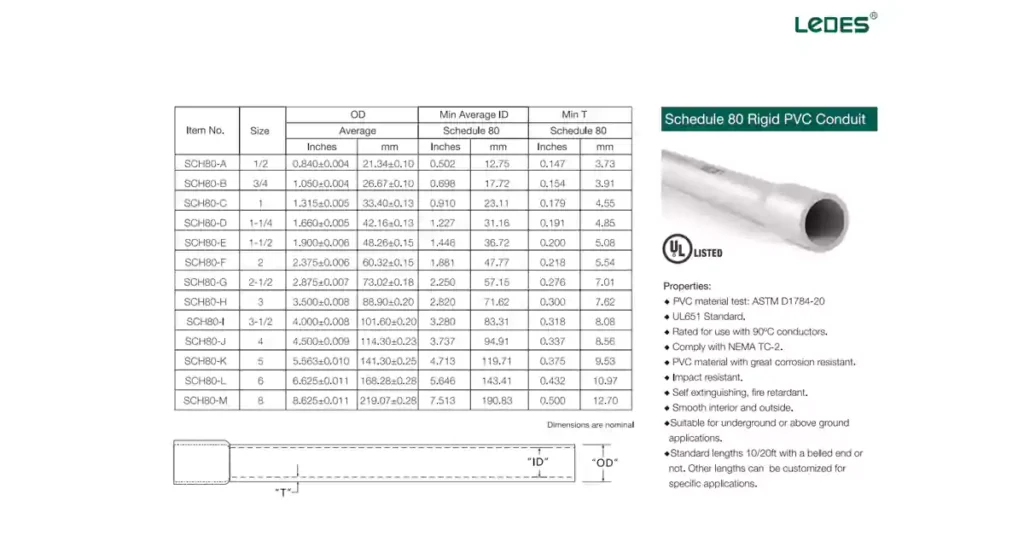
جدول 80 أبعاد القناة الكهربائية PVC
جدول 40 أنابيب PVC يتميز بجدار أرق نسبيًا مقارنة بالجدول 80. يجعل الجدار الأرق أنابيب الجدول 40 أخف وزنًا وأسهل في التعامل أثناء التركيب. إنه خيار شائع للتطبيقات حيث لا يتعرض الأنبوب لضغط مادي كبير أو ظروف بيئية قاسية.
على الجانب الآخر، جدول 80 من أنابيب PVC يتميز بجدار أكثر سمكًا، مما يوفر قوة ميكانيكية ومتانة متزايدة. تعمل السُمك الإضافي على تعزيز قدرته على تحمل الضغوط الخارجية والصدمات والقوى الضارة الأخرى المحتملة. تُستخدم أنابيب الجدول 80 عادةً في التطبيقات حيث توجد احتمالية أعلى للإجهاد البدني أو التعرض لبيئات قاسية، مثل التركيبات الخارجية أو الإعدادات الصناعية.
يمكن أن يؤثر الاختلاف في سمك الجدار أيضًا على عوامل أخرى، مثل الأداء الكهربائي والتكلفة. قد توفر الجدران السميكة في قناة الجدول 80 خصائص عزل كهربائي محسنة، خاصة في المواقف التي تكون فيها هناك حاجة إلى حماية معززة ضد التداخل الكهربائي أو العوامل الخارجية. ومع ذلك، من المهم ملاحظة أن خصائص الأداء المحددة وتأثيرات التكلفة قد تختلف وفقًا للشركة المصنعة ومتطلبات التطبيق المحددة.
يعد فهم الفروق في سمك الجدار بين الجدول 40 والجدول 80 من قنوات PVC أمرًا ضروريًا لاختيار القناة المناسبة لتركيب كهربائي معين. وينبغي أن تؤخذ في الاعتبار عوامل مثل الظروف البيئية المتوقعة، والإجهاد الميكانيكي، واعتبارات الميزانية عند اتخاذ القرار بين الخيارين.
- يظهر أنبوب الجدول 80 متانة أكبر ومقاومة أكبر للتأثير مقارنة بأنابيب الجدول 40.
- يوفر معيار UL 651 طرق اختبار لمقاومة التأثير ومقاومة السحق، مما يوضح الأداء المادي المتفوق للجدول 80.
بالإضافة إلى الاختلاف في سمك الجدار، يُظهر الجدول 40 والجدول 80 من قنوات PVC أيضًا اختلافات في خصائص الأداء. يمكن ملاحظة هذه الاختلافات من خلال طرق الاختبار مثل مقاومة الصدمات ومقاومة السحق، كما هو موضح في معيار UL 651. توضح مقارنة القيم التي تم الحصول عليها من هذه الاختبارات بوضوح أن قناة الجدول 80 تقدم أداءً بدنيًا فائقًا.
عندما يتعلق الأمر بمقاومة الصدمات، فإن قناة الجدول 80 PVC توضح متانة معززة مقارنة بالجدول 40. ويقيم اختبار مقاومة الصدمات قدرة القناة على تحمل القوى الخارجية، مثل الصدمات أو الضربات العرضية. نظرًا لجدارها السميك، تُظهر قناة الجدول 80 مقاومة أكبر للأضرار الناجمة عن الصدمات، مما يجعلها اختيارًا مناسبًا للتطبيقات التي يوجد فيها خطر أكبر للإجهاد البدني.
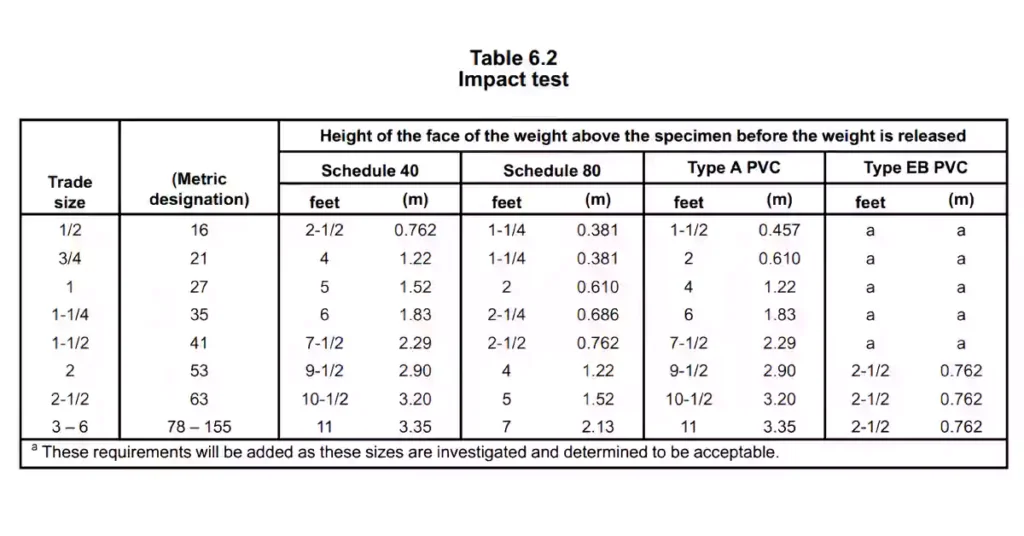
تأتي هذه البيانات من الطبعة الثامنة من معيار UL 651 للسلامة، والملكية مملوكة لشركة UL.
وفقًا لمعيار UL 651، يتم إجراء اختبار التأثير لأنابيب PVC الصلبة على النحو التالي:
- يتم قطع عشر عينات مقاس 6 بوصات (150 مم) بدون شقوق أو تمزقات أو عيوب من الأطوال النهائية لكل حجم تجاري من قناة PVC الصلبة.
- يتم تكييف العينات في الهواء عند درجة حرارة 23.0 ±0 درجة مئوية (73.4 ±3.6 درجة فهرنهايت) لمدة لا تقل عن 4 ساعات قبل الاختبار.
- يتم اختبار العينات بشكل فردي في غضون 15 ثانية بعد التكييف، أثناء وضعها على لوح فولاذي مسطح صلب لا يقل سمكه عن 1/2 بوصة (13 مم) ومثبت بقوة مع سطحه العلوي أفقيًا.
- يحيط القفص الواقي بالألواح والعينات لتقليل خطر الإصابة بسبب قطع القناة المكسورة.
- وزن فولاذي، على شكل أسطوانة صلبة دائرية يمينية ذات وجه تصادم مسطح ذو حواف مستديرة، يسقط بحرية من خلال دليل رأسي من ارتفاع محدد وفقًا للجدول 6.2 في معيار UL 651.
- بالنسبة للجدول 40، للقناة الصلبة PVC من النوع A وEB، يبلغ الوزن 20 رطلاً (9.7 كجم) ويبلغ قطر الأسطوانة 2 بوصة (51 مم). بالنسبة لقناة الجدول 80، يبلغ الوزن 75 رطلاً (34 كجم) ويبلغ قطر الأسطوانة 6 بوصات (150 ملم).
- يضرب الوجه المسطح للوزن مركز العينة عبر القطر وعلى طول المحور الطولي مرة واحدة، مما يضمن عدم سقوط الوزن على العينة أكثر من مرة.
- يجب ألا تظهر على قناة PVC الصلبة شقوق أو تمزقات أطول من 1/32 بوصة (0.8 مم) على طول السطح الخارجي في أكثر من ثلاثة من العينات العشر.
وفقًا لمعيار UL 651، يتم إجراء اختبار السحق لموصلات PVC الصلبة على النحو التالي:
- يتم اختبار عينات مقاس 6 بوصات (150 مم) من قنوات PVC الصلبة النهائية.
- يجب ألا تتسطح العينات إلى درجة التواء تحت الحمل المحدد في الجدول 6.3.
- يجب ألا يقل المحور الصغير المقاس داخل كل عينة محملة عن 70% من القطر الداخلي للعينة المقاسة قبل التحميل.
- يتم قطع ثلاث عينات من الأطوال النهائية لكل حجم من أنابيب PVC الصلبة.
- يجب أن تكون العينات وآلة الاختبار والهواء المحيط في حالة توازن حراري عند درجة حرارة 23.0 ±2.0 درجة مئوية (73.4 ±3.6 درجة فهرنهايت) أثناء الاختبار.
- يتم قياس القطر الداخلي لكل عينة قبل الاختبار.
- يتم اختبار العينات بشكل فردي بين زوج من الألواح الفولاذية الصلبة والمسطحة التي لا يقل طولها عن 6 بوصات (150 مم) وأفقية ومتوازية مع بعضها البعض.
- يتم تحريك إحدى الصفائح تجاه الأخرى بمعدل 1/2 ±1/8 بوصة (10.0 ±2.5 مم) في الدقيقة حتى يتم تطبيق الحمل المحدد في الجدول 6.1، كما هو موضح في قرص آلة الاختبار.
- يجب ألا تظهر على قناة PVC الصلبة أي علامات للانسحاب من التلامس مع أي من اللوحتين أثناء أو بعد تطبيق الحمل (الانبعاج).
- يجب ألا يقل المحور الصغير المقاس داخل أي عينة مسطحة عن النسبة المحددة في الجدول 6.3 للقطر الداخلي لتلك العينة كما تم قياسه قبل التحميل.
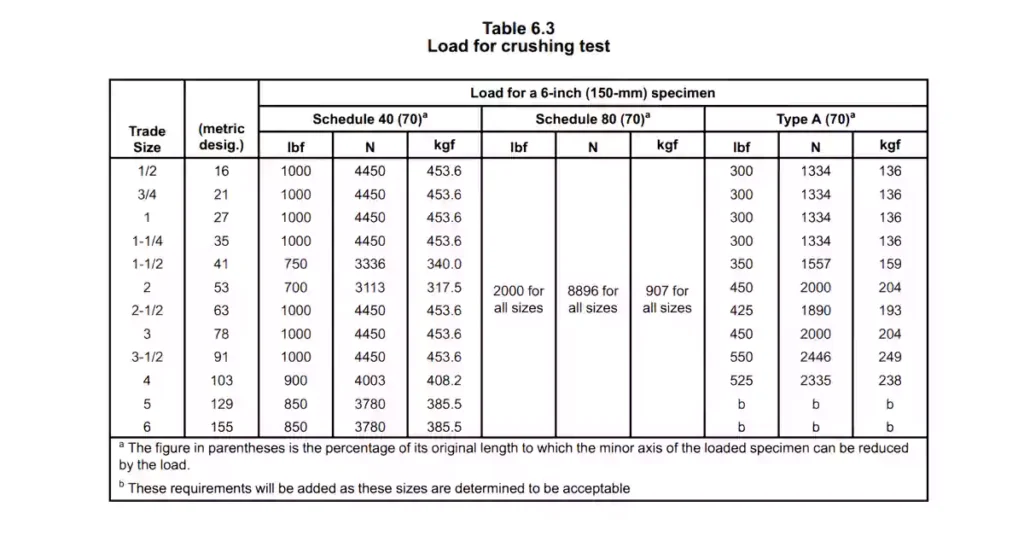
تأتي هذه البيانات من الطبعة الثامنة من معيار UL 651 للسلامة، والملكية مملوكة لشركة UL.
ومن الجدير بالذكر أن مصنعي أنابيب PVCمثل ليديس، نستثمر باستمرار في البحث والتطوير لضمان أن يكون سمك الجدار المتزايد في أنابيب الجدول 80 مصحوبًا بأداء ثابت في جميع الجوانب. هذا الالتزام بتحسين المنتج يضمن أن الأنابيب تلبي معايير شهادة UL، بل وتتجاوزها في كثير من الأحيان، بالإضافة إلى تجاوزها لتوقعات العملاء.
على سبيل المثال، تم بنجاح نشر سلسلة قنوات Ledes Table 40 وSchedule 80 PVC واستخدامها في مشاريع بارزة مثل CHPE وAB Brown Station في الولايات المتحدة. لقد أثبتت هذه المشاريع أن قناة Ledes لا تلبي معايير شهادة UL فحسب، بل تتجاوز أيضًا توقعات العملاء من حيث الأداء العام والموثوقية.
من خلال فهم اختلافات الأداء بين الجدول 40 والجدول 80 من قنوات PVC، يصبح من الواضح أن اختيار القناة المناسبة يجب أن يأخذ في الاعتبار المتطلبات المحددة للتركيبات الكهربائية. ينبغي النظر بعناية في عوامل مثل الإجهاد الجسدي المتوقع، والظروف البيئية، ومعايير الصناعة لضمان الأداء الأمثل وطول عمر نظام القناة.
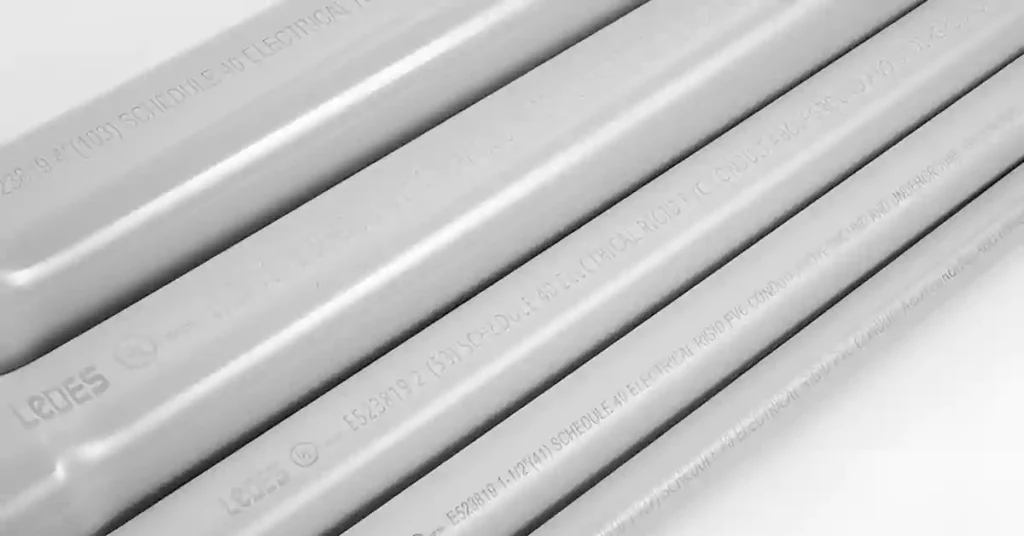
- تعتبر الأنابيب من النوع 80 أكثر تكلفة بشكل عام بسبب زيادة سمك جدارها ومتطلبات المواد.
استنادًا إلى التحليل والمقارنة السابقين، يمكن استنتاج أن الجدول 80 أكثر تكلفة بشكل عام من الجدول 40. ويعود فرق السعر هذا في المقام الأول إلى زيادة سمك الجدار ومتطلبات المواد الأعلى المرتبطة بقناة الجدول 80.
يتطلب الجدار السميك لمواسير الجدول 80 المزيد من المواد الخام، مما يساهم في ارتفاع تكلفة التصنيع. بالإضافة إلى ذلك، قد تشتمل عمليات الإنتاج الخاصة بقناة الجدول 80 على خطوات إضافية أو معدات متخصصة لتحقيق السُمك المطلوب، مما يزيد من التكلفة الإجمالية.
علاوة على ذلك، فإن زيادة وزن قناة الجدول 80، الناتجة عن جدارها السميك، يمكن أن تؤدي إلى ارتفاع تكاليف النقل والمناولة أثناء التركيب. يتطلب الوزن الإضافي المزيد من الجهد والموارد للشحن والمناولة والرفع، مما قد يؤدي إلى نفقات إضافية.
ونتيجة لذلك، تختار العديد من المشاريع قناة الجدول 40 لأنها توفر حلاً فعالاً من حيث التكلفة مع الاستمرار في تلبية المتطلبات الضرورية. يتم استخدام قناة الجدول 40 على نطاق واسع في التطبيقات المختلفة حيث قد لا تكون زيادة القوة والمتانة للجدول 80 ضرورية.
ومع ذلك، من المهم ملاحظة أن اختيار نوع القناة يجب أن يأخذ في الاعتبار الاحتياجات والمتطلبات المحددة للمشروع. إذا كان لمشروعك اعتبارات أو متطلبات خاصة، فمن المستحسن التشاور معنا للحصول على معلومات وإرشادات أكثر تفصيلاً.
في النهاية، تعد الموازنة بين متطلبات الأداء والتكاليف المرتبطة بها أمرًا بالغ الأهمية في اتخاذ قرار مستنير بشأن جدول موازنة قناة PVC الأكثر ملاءمة لتطبيقك المحدد.
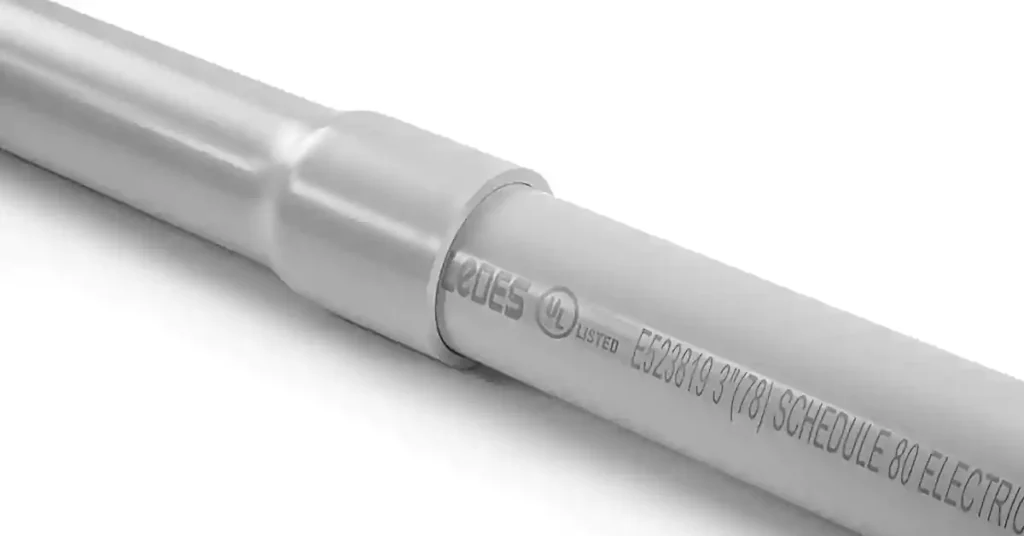
- كلا النوعين من الأنابيب لهما نفس الأبعاد ويمكن استخدام نفس التركيبات للتوصيلات.
- ينبغي اتباع ممارسات التثبيت الصحيحة وفقًا للرموز والإرشادات المحلية ذات الصلة.
نظرًا لأن UL والمعايير ذات الصلة قد حددت أن قنوات الجدول 40 والجدول 80 لها أبعاد متطابقة، فهذا يعني أنه يمكنهم استخدام نفس التركيبات للتوصيلات. ومع ذلك، فمن المهم الالتزام بالمعايير ذات الصلة لكل بلد أثناء عملية التثبيت.
في الولايات المتحدة، يوفر قانون الكهرباء الوطني (NEC) إرشادات للتركيب الصحيح لقناة PVC. تتضمن هذه الإرشادات تعليمات لتنظيف القناة وإجراء التوصيلات وضمان السلامة الكهربائية العامة.
هنا 8 نصائح للتثبيت من كل من جدول 40 وجدول 80:
- التخطيط والتصميم: حدد حجم ومسار الأنبوب المناسب للتركيب الكهربائي. ضع في اعتبارك عوامل مثل عدد وحجم الموصلات والظروف البيئية وأي متطلبات محددة للمشروع.
- القطع والتثقيب: استخدم الأدوات المناسبة لقص أقسام الأنابيب إلى الأطوال المطلوبة. بعد القطع، قم بإزالة أي نتوءات أو حواف حادة باستخدام أداة أو مبرد لضمان سطح أملس ونظيف للتركيبات والتوصيلات المناسبة.
- تنظيف: قم بتنظيف الجزء الداخلي من الأنبوب جيدًا باستخدام مذيب أو منظف مناسب لإزالة أي حطام أو أوساخ أو رطوبة قد تعيق التركيب أو تؤثر على الأداء الكهربائي.
- التركيبات والتوصيلات: اختر التركيبات المتوافقة مع نوع الأنابيب المختار (الجدول 40 أو الجدول 80). اتبع تعليمات الشركة المصنعة لعمل توصيلات آمنة ومحكمة الغلق، مثل استخدام الأسمنت المذيب أو الموصلات الميكانيكية.
- الدعم المناسب: قم بتثبيت دعامات الأنابيب على فترات زمنية مناسبة لضمان المحاذاة الصحيحة ومنع الترهل أو الإجهاد المفرط على الأنابيب. اتبع قوانين البناء واللوائح المحلية فيما يتعلق بمسافات الدعامات وطرق التثبيت.
- الانحناء: إذا لزم الأمر، استخدم تقنيات وأدوات الانحناء المناسبة لإنشاء انحناءات في الأنابيب. تجنب الانحناء المفرط، حيث يمكن أن يؤدي ذلك إلى إضعاف الأنابيب والتأثير على أدائها الإجمالي.
- التأريض: اتبع معايير NEC أو القوانين المحلية ذات الصلة لمتطلبات التأريض. وثّق نظام التوصيلات الكهربائية جيدًا وأُرِّضه لضمان السلامة الكهربائية.
- الختم والحماية: استخدم طرق الختم المناسبة، مثل المواد المانعة للتسرب أو الحشوات المتوافقة مع مادة البولي فينيل كلوريد، عند نقاط الدخول للحماية من دخول الرطوبة. قم بتركيب الأنابيب في أماكن محمية بشكل كافٍ من التلف المادي، مثل الصدمات أو التعرض لعناصر قاسية.
استشر دائمًا والتزم بالإرشادات واللوائح المحددة التي تقدمها السلطات ومنظمات المعايير ذات الصلة في بلدك أو منطقتك. تعتبر ممارسات التثبيت الصحيحة أمرًا بالغ الأهمية للحفاظ على سلامة وسلامة نظام القناة الكهربائية.
نصائح احترافية: هل ترغب بمعرفة المزيد عن تركيب الأنابيب الكهربائية؟ أعددنا لك دليلاً شاملاً لتركيب أنابيب PVC. يمكنك الضغط للذهاب إلى هناك.
- تعتبر الأنابيب ذات الجدول 40 مناسبة للتطبيقات السكنية والتجارية والصناعية الخفيفة، بالإضافة إلى التركيبات الداخلية والمناطق ذات الحركة المرورية المنخفضة.
- يُعد استخدام الأنابيب من الجدول 80 مفضلًا للمرافق الصناعية الثقيلة والمصانع الكيميائية والمنشآت الخارجية وتحت الأرض والمواقع الخطرة والغرف الميكانيكية.
يوفر أنبوب PVC من الجدول 40 الحماية ويوجه الأسلاك الكهربائية في الجدران والأرضيات والأسقف وحتى تطبيقات الدفن المباشر بشكل آمن، ويلبي معايير NEC 352 للاستخدام السكني والتجاري والصناعي.
- المباني السكنية: تُستخدم أنابيب الجدول 40 بشكل شائع في البناء السكني لتركيب الأسلاك الكهربائية. وهي مناسبة للبيئات السكنية النموذجية حيث يكون خطر التلف المادي أو الظروف القاسية منخفضًا نسبيًا.
- المباني التجارية: في المناطق غير المتطلبة للهياكل التجارية، مثل المكاتب أو متاجر التجزئة أو الشركات الصغيرة، غالبًا ما يتم استخدام أنابيب الجدول 40. فهي توفر الحماية الكافية للأسلاك الكهربائية دون الحاجة إلى القوة المعززة للجدول 80.
- المرافق الصناعية الخفيفة: يمكن لبعض التطبيقات الصناعية الخفيفة، مثل ورش العمل أو مرافق التصنيع الصغيرة، حيث يكون خطر الاصطدام أو الظروف القاسية ضئيلاً، أن تستفيد من فعالية تكلفة أنابيب الجدول 40.
- التركيبات الداخلية: تُستخدم الأنابيب من الجدول 40 عادةً في التركيبات الكهربائية الداخلية، بما في ذلك الأسلاك في الجدران والأسقف والأرضيات، حيث توفر الحماية ضد التلف المادي وتساعد في تنظيم الأسلاك الكهربائية وتوجيهها بكفاءة.
- المناطق ذات حركة المرور المنخفضة: يمكن للمواقع التي بها حركة مرور قليلة على الأقدام، مثل غرف التخزين أو خزائن المرافق، حيث يكون احتمال تعرض الأنابيب للتأثيرات العرضية أقل، أن تستخدم أنابيب الجدول 40 بسبب تكلفتها المنخفضة وقدرات الحماية الكافية.
يوفر مجرى الجدول 80 الحماية ويوجه الأسلاك الكهربائية في الجدران والأرضيات والأسقف وحتى تطبيقات الدفن المباشر بشكل آمن، ويلبي معايير NEC 352 للاستخدام السكني والتجاري والصناعي.
- المرافق الصناعية الثقيلة: تُستخدم أنابيب الجدول 80 غالبًا في البيئات الصناعية الثقيلة حيث توجد مخاطر أعلى للصدمات أو التعرض للمواد الكيميائية أو درجات الحرارة العالية أو الإجهاد الميكانيكي الأكبر. وهي توفر حماية فائقة للأسلاك الكهربائية في هذه البيئات الصعبة.
- المصانع الكيميائية ومرافق المعالجة: تتطلب البيئات التي تحتوي على مواد أو مواد كيميائية تآكلية استخدام أنابيب الجدول 80 لتحمل التأثيرات التآكلية المحتملة وتوفير حماية قوية للأنظمة الكهربائية.
- التركيبات الخارجية وتحت الأرض: يُعد أنبوب الجدول 80 مفضلًا للتطبيقات الخارجية وتحت الأرض حيث قد يتعرض الأنبوب للأشعة فوق البنفسجية أو الرطوبة أو ضغط التربة أو التلف المحتمل الناجم عن أنشطة الحفر. فهو يوفر متانة ومقاومة أكبر للقوى الخارجية.
- المواقع الخطرة: تتطلب المناطق المصنفة على أنها خطرة، مثل مصافي النفط أو مصانع البتروكيماويات أو المرافق التي تحتوي على غازات قابلة للاشتعال أو الغبار، القوة والمتانة الإضافية لأنابيب الجدول 80 لضمان سلامة الأنظمة الكهربائية.
- الغرف والمعدات الميكانيكية: تعتبر الأنابيب من الجدول 80 مناسبة لإيواء الأسلاك الكهربائية في المناطق التي تحتوي على معدات ميكانيكية ثقيلة، مثل المولدات أو المضخات أو الآلات الصناعية، حيث توجد اهتزازات وإجهادات ميكانيكية.
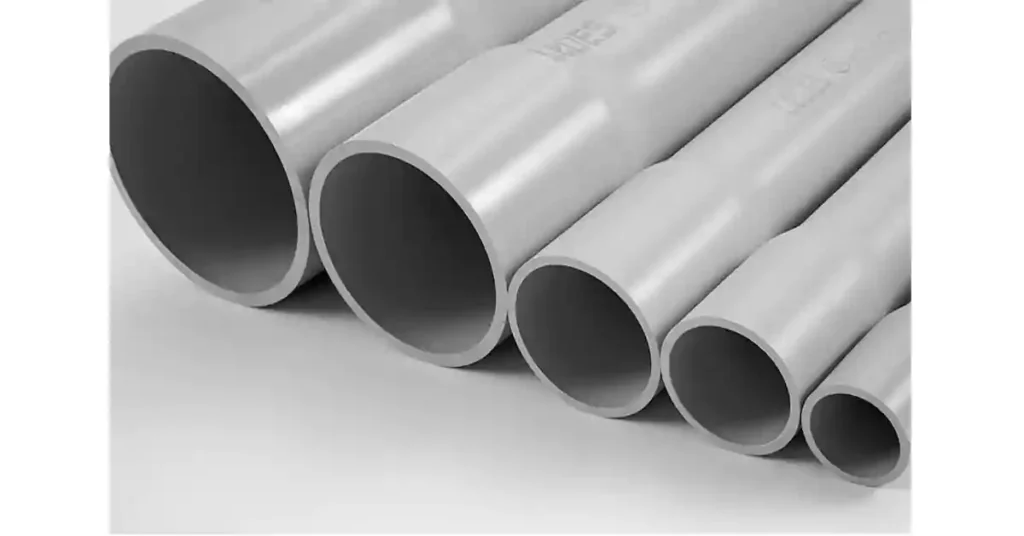
- مورد العلامة التجارية الموثوق به: يعد اختيار مورد علامة تجارية موثوقة أمرًا بالغ الأهمية عند شراء الأنابيب الكهربائية. على سبيل المثال، تتمتع علامة تجارية مرموقة مثل Ledes بسجل حافل في تقديم منتجات وحلول عالية الجودة. تشتهر Ledes بالتزامها بالتميز والإبداع، وتقدم مجموعة شاملة من أنظمة الأنابيب الكهربائية المصممة لتلبية معايير الصناعة وضمان التركيبات الكهربائية الموثوقة.
- الالتزام بمعايير البناء المحلية:من الضروري التأكد من أن الأنابيب الكهربائية التي تشتريها تتوافق مع معايير البناء المحلية والأكواد. على سبيل المثال، في الولايات المتحدة، تحدد المدونة الكهربائية الوطنية (NEC) المعايير الخاصة بالتركيبات الكهربائية. يجب أن تلبي الأنابيب التي تختارها متطلبات NEC لضمان السلامة والامتثال للوائح المحلية.
- الخدمات التي يقدمها المورد: بالإضافة إلى المنتج نفسه، ضع في اعتبارك الخدمات التي يقدمها المورد. ويشمل ذلك عوامل مثل النقل والتسليم ودعم ما بعد البيع. سيقدم المورد الموثوق به خيارات نقل فعّالة، مما يضمن وصول الأنابيب إلى موقعك في الوقت المناسب. يجب أن يكون لديهم أيضًا فريق خدمة عملاء سريع الاستجابة يمكنه معالجة أي استفسارات أو مشكلات قد تواجهها بعد الشراء.
- جودة المنتج والمتانة: قم بتقييم جودة ومتانة الأنابيب الكهربائية المعروضة. ابحث عن المنتجات التي خضعت لاختبارات صارمة، مثل مقاومة اللهب واختبارات درجات الحرارة القصوى. تضمن الأنابيب عالية الجودة أداءً طويل الأمد، مما يقلل الحاجة إلى الاستبدال والصيانة المتكررة.
- التوافق والتنوع: ضع في اعتبارك مدى توافق نظام التوصيلات الكهربائية وتعدد استخداماته. يجب أن يكون قادرًا على استيعاب أنواع مختلفة من الأسلاك وأن يكون مناسبًا لتطبيقات مختلفة. سيوفر اختيار نظام توصيلات مزود بمجموعة واسعة من التركيبات والملحقات مرونة في التركيب وتلبية المتطلبات المحددة لمشروعك.
بشكل عام، تعد القناة الكهربائية جزءًا مهمًا في الأنظمة الكهربائية، ويعتبر الجدول 40 والجدول 80 من قنوات PVC أكثر أنواع القنوات استخدامًا في السوق، حيث يشتركان في نفس الوظائف والخصائص، لكنهما يختلفان في تفاصيل الأداء والأبعاد والتطبيقات. عند اختيار هذين النوعين، ضع في اعتبارك احتياجات ومتطلبات مشروعك الخاصة لاختيار النوع المناسب.
هذا كل شيء. لا تتردد في الاتصال بنا إذا كان لديك أي أسئلة. يمكنك ببساطة أرسل لنا بريدًا إلكترونيًا.




